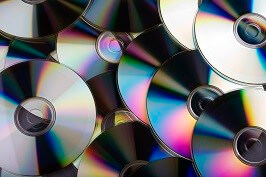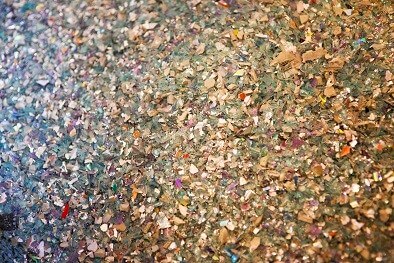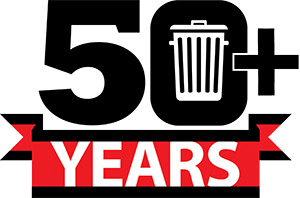Reduce E-Waste by Following This CD/DVD Recycling Guide
Technology is always changing. Always evolving. What becomes the standard medium evolves into something completely different and typically requires a new set of hardware. From vinyl to  cassettes, CDs to MP3s and now, streaming music services, we find ourselves upgrading to the latest, greatest technology. But, what happens to the old stuff? E-waste is a growing problem and much of the hardware, as well as the discs and drives that we use with that hardware contain hazardous chemicals that can harm our landfills. Because these discs from yesteryear can’t be put in your Novak single-stream recycling bin, let’s show you how to reduce your e-waste through CD recycling.
cassettes, CDs to MP3s and now, streaming music services, we find ourselves upgrading to the latest, greatest technology. But, what happens to the old stuff? E-waste is a growing problem and much of the hardware, as well as the discs and drives that we use with that hardware contain hazardous chemicals that can harm our landfills. Because these discs from yesteryear can’t be put in your Novak single-stream recycling bin, let’s show you how to reduce your e-waste through CD recycling.
 cassettes, CDs to MP3s and now, streaming music services, we find ourselves upgrading to the latest, greatest technology. But, what happens to the old stuff? E-waste is a growing problem and much of the hardware, as well as the discs and drives that we use with that hardware contain hazardous chemicals that can harm our landfills. Because these discs from yesteryear can’t be put in your Novak single-stream recycling bin, let’s show you how to reduce your e-waste through CD recycling.
cassettes, CDs to MP3s and now, streaming music services, we find ourselves upgrading to the latest, greatest technology. But, what happens to the old stuff? E-waste is a growing problem and much of the hardware, as well as the discs and drives that we use with that hardware contain hazardous chemicals that can harm our landfills. Because these discs from yesteryear can’t be put in your Novak single-stream recycling bin, let’s show you how to reduce your e-waste through CD recycling.What is E-Waste?
E-waste is short for electronic waste nearing the end of its “useful life.” E-Waste can be any outdated or obsolete appliance or electronic device found in offices, homes, and pants pockets. Televisions, microwaves, computers and cell phones are all common examples of e-waste.
E-waste is becoming a growing problem because in our technology-driven age, the useful lifespan for devices and products is getting shorter and shorter. Consumers demand the “the next best” thing and companies answer that demand by updating and improving devices. Not only should e-waste be kept out of your trash receptacle, it should also be kept out of your single-stream recycling bin. E-waste requires special disposal and has a very specific recycling process, which is why it’s becoming such a problem.
What are CDs and DVDs Made of?
CD/DVD recycling is so easy because of the materials they’re made of. Even though CDs are made of highly valuable recyclable materials like polycarbonate plastic and aluminum, they’re not accepted in Novak single-stream recycling bins. CD recycling saves substantial amounts of energy and prevents significant amounts of both air and water pollution attributed to the manufacturing of these items from raw material.
Each year, billions of CDs (and DVDs) are manufactured, while millions are simply thrown away. They end up in landfills and incinerators, which causes unnecessary damage to our environment, wasted energy, and the loss of valuable resources. Landfills are not a viable disposal option because CDs don’t break down readily. Over time, CDs can release Bisphenol A (BPA), which can cause health implications in humans. Burning CDs releases toxic fumes into the air we breathe, and they require a special recycling process that isn’t accepted in single-stream recycling bins.
Consider This:
E-waste is short for electronic waste nearing the end of its “useful life.” E-Waste can be any outdated or obsolete appliance or electronic device found in offices, homes, and pants pockets. Televisions, microwaves, computers and cell phones are all common examples of e-waste.
E-waste is becoming a growing problem because in our technology-driven age, the useful lifespan for devices and products is getting shorter and shorter. Consumers demand the “the next best” thing and companies answer that demand by updating and improving devices. Not only should e-waste be kept out of your trash receptacle, it should also be kept out of your single-stream recycling bin. E-waste requires special disposal and has a very specific recycling process, which is why it’s becoming such a problem.
What are CDs and DVDs Made of?
CD/DVD recycling is so easy because of the materials they’re made of. Even though CDs are made of highly valuable recyclable materials like polycarbonate plastic and aluminum, they’re not accepted in Novak single-stream recycling bins. CD recycling saves substantial amounts of energy and prevents significant amounts of both air and water pollution attributed to the manufacturing of these items from raw material.
Each year, billions of CDs (and DVDs) are manufactured, while millions are simply thrown away. They end up in landfills and incinerators, which causes unnecessary damage to our environment, wasted energy, and the loss of valuable resources. Landfills are not a viable disposal option because CDs don’t break down readily. Over time, CDs can release Bisphenol A (BPA), which can cause health implications in humans. Burning CDs releases toxic fumes into the air we breathe, and they require a special recycling process that isn’t accepted in single-stream recycling bins.
Consider This:
- To manufacture a pound of plastic (30 CDs per pound), it requires 300 cubic feet of natural gas, 2 cups of crude oil and 24 gallons of water.
- It is estimated that it will take over 1 million years for a CD to completely decompose in a landfill.
- More than 5.5 million boxes of software go to landfills and incinerators, plus people throw away millions of music CDs each year!
- Every month approximately 100,000 pounds of CDs become obsolete (outdated, useless, or unwanted). Source: Ecocoalition.org
And This:
- It is estimated that AOL alone has distributed more than 2 billion CDs. That is the natural gas equivalent of heating 200,000 homes for 1 year.
- A CD can take 1 million years to decompose in a landfill.
- CDs can be recycled for use in new products. Specialized electronic recycling companies clean, grind, blend, and compound the discs into a high-quality plastic for a variety of uses, including: automotive industry parts, raw materials to make plastics (Discs are ground into a gravel-like substance, which is sold to companies that melt it down and convert it to plastic), office equipment, alarm boxes and panels, street lights, and electrical cable insulation, and even jewel cases.
- In 1983, when CDs were introduced in the United States, 800,000 discs were sold. By 1990, this number had grown to close to 1 billion!
- More than 5.5 million boxes of software go to landfills and incinerators, plus people throw away millions of music CDs each year! Source: backthruthefuture.com
What Can I Do?
Reduce:
- Converting to a digital streaming service like Pandora, Spotify, Google Music, Amazon Music, or Apple Radio are all great ways to listen to your favorite music.
- Services like Hulu and Netflix cut down on the amount of DVDs you have to buy or rent to view your favorite shows.
- By switching from physical to digital, you reduce the amount of e-waste you produce. As providers of content
 see that less physical media is being consumed, they decrease production on products that can produce e-waste.
see that less physical media is being consumed, they decrease production on products that can produce e-waste.
Recycle:
- The Compact Disc Recycling Center was founded in 2006 to provide consumers and companies education, awareness, and options for easy CD and DVD recycling. The website provides valuable information on how to take part in and where to find CD recycling near them.
- Free CD/DVD Recycling & Free Hard Drive Recycling services are offered by Back Thru The Future Technology Disposal to consumers.
Even though CDs and DVDs can’t be placed in your single-stream recycling bin, Novak Sanitary Service offers residential service that include bi-weekly, curbside recycling along with weekly trash collection. If you have any questions about residential service, or would like to request service, please contact us or call us at 605-338-7126.
Last Modified:




